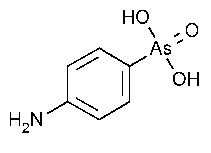Arsanilic Acid
»Arsanilic Acid contains not less than 98.0percent and not more than 102.0percent of C6H8AsNO3,calculated on the dried basis.
Packaging and storage—
Preserve in well-closed containers.
Labeling—
Label it to indicate that it is for veterinary use only.
Identification,Infrared Absorption á197Kñ.
Loss on drying á731ñ—
Dry it in vacuum at 80 for 4hours:it loses not more than 0.5%of its weight.
for 4hours:it loses not more than 0.5%of its weight.
Limit of o-arsanilic acid—
Mobile phase—
Dissolve 4.04g of monobasic potassium phosphate in 985mLof water,add 2mLof phosphoric acid,and mix.Add 10mLof methanol,mix,and degas.Make adjustments if necessary (see System Suitabilityunder Chromatography á621ñ).
Standard solution—
Transfer about 67mg of o-arsanilic acid,accurately weighed,to a 100-mLvolumetric flask,add about 65mg of warm (about 70 to 80
to 80 )water,and shake or sonicate to dissolve.Allow to cool,dilute with water to volume,and mix.Dilute a portion of this solution quantitatively and stepwise with water to obtain a solution having a known concentration of about 0.0012mg of o-arsanilic acid per mL.
)water,and shake or sonicate to dissolve.Allow to cool,dilute with water to volume,and mix.Dilute a portion of this solution quantitatively and stepwise with water to obtain a solution having a known concentration of about 0.0012mg of o-arsanilic acid per mL.
Test solution—
Transfer about 50mg of Arsanilic Acid,accurately weighed,to a 50-mLvolumetric flask,add about 30mLof warm water,and shake or sonicate to dissolve.Allow to cool,dilute with water to volume,and mix.
Chromatographic system
(see Chromatography á621ñ)—The liquid chromatograph is equipped with a 242-nm detector and a 4.6-mm ×15-cm column that contains 5-µm base-deactivated packing L1and is maintained at a constant temperature of about 30 .The flow rate is about 1.5mLper minute.Chromatograph the Standard solution,and record the peak responses as directed for Procedure:the capacity factor,k¢,for the o-arsanilic acid peak is between 2.8and 3.8;and the relative standard deviation for replicate injections is not more than 2.5%.
.The flow rate is about 1.5mLper minute.Chromatograph the Standard solution,and record the peak responses as directed for Procedure:the capacity factor,k¢,for the o-arsanilic acid peak is between 2.8and 3.8;and the relative standard deviation for replicate injections is not more than 2.5%.
Procedure—
Separately inject equal volumes (about 20µL)of the Standard solutionand the Test solutioninto the chromatograph,record the chromatograms,and measure the areas of the responses for the o-arsanilic acid peaks.Calculate the percentage of o-arsanilic acid in the portion of Arsanilic Acid taken by the formula:
5000(C/W)(rU/rS),
in which Cis the concentration,in mg per mL,of o-arsanilic acid in the Standard solution;Wis the weight,in mg,of Arsanilic Acid taken to prepare the Test solution;and rUand rSare the responses of the o-arsanilic acid peaks obtained from the Test solutionand the Standard solution,respectively:not more than 0.12%is found.
Limit of aniline—
Mobile phase—
Dissolve 7.76g of monobasic potassium phosphate in 950mLof water,add 50mLof methanol,mix,and degas.Make adjustments if necessary (see System Suitabilityunder Chromatography á621ñ).
Standard solution—
Transfer about 176mg of aniline,accurately weighed,to a 25-mLvolumetric flask,add about 1mLof methanol,swirl,then add about 15mLof water,and shake to dissolve.Dilute with water to volume,and mix.Dilute a portion of this solution quantitatively and stepwise with water to obtain a solution having a known concentration of about 0.00045mg of aniline per mL.
Test solution—
Transfer about 50mg of Arsanilic Acid,accurately weighed,to a 50-mLvolumetric flask,add about 30mLof warm (about 70 to 80
to 80 )water,and shake or sonicate to dissolve.Allow to cool,dilute with water to volume,and mix.
)water,and shake or sonicate to dissolve.Allow to cool,dilute with water to volume,and mix.
Chromatographic system
(see Chromatography á621ñ)—The liquid chromatograph is equipped with a 235-nm detector and a 4.6-mm ×15-cm column that contains 5-µm base-deactivated packing L1and is maintained at a constant temperature of about 30 .The flow rate is about 1.5mLper minute.Chromatograph the Standard solution,and record the peak responses as directed for Procedure:the capacity factor,k¢,for the aniline peak is between 2.3and 3.3;and the relative standard deviation for replicate injections is not more than 3.0%.
.The flow rate is about 1.5mLper minute.Chromatograph the Standard solution,and record the peak responses as directed for Procedure:the capacity factor,k¢,for the aniline peak is between 2.3and 3.3;and the relative standard deviation for replicate injections is not more than 3.0%.
Procedure—
Separately inject equal volumes (about 50µL)of the Standard solutionand the Test solutioninto the chromatograph,record the chromatograms,and measure the areas of the responses for the aniline peaks.Calculate the percentage of aniline in the portion of Arsanilic Acid taken by the formula:
5000(C/W)(rU/rS),
in which Cis the concentration,in mg per mL,of aniline in the Standard solution;Wis the weight,in mg,of Arsanilic Acid taken to prepare the Test solution;and rUand rSare the responses of the aniline peaks obtained from the Test solutionand the Standard solution,respectively:not more than 0.045%is found.
Assay—
Transfer about 125mg of Arsanilic Acid,accurately weighed,to a 50-mLconical flask,and add 10.0mLof a mixture of sulfuric acid,nitric acid,and perchloric acid (1000:50:50)and several glass beads.Digest on a hot plate for about 1hour,increasing the temperature of the hot plate in steps until a ring of sulfuric acid rises into the neck of the flask.Allow to cool,to the colorless solution add about 400mg of hydrazine sulfate,and heat the flask vigorously on a hot plate until a ring of sulfuric acid rises into the neck of the flask.Allow to cool,and wash down the rim,neck,and insides of the flask with about 1mLof water.Heat the flask again until a ring of sulfuric acid rises into the neck of the flask.Allow to cool,and transfer the colorless solution,with the aid of about 80mLof water,to a 125-mLconical flask.Add 10mLof hydrochloric acid and several drops of 0.002Mpotassium iodide,cool to between 0 and 5
and 5 ,and titrate with 0.1Npotassium permanganate VSto a pale pink endpoint,maintaining the temperature between 0
,and titrate with 0.1Npotassium permanganate VSto a pale pink endpoint,maintaining the temperature between 0 and 5
and 5 during the titration.Perform a blank determination,and make any necessary correction.Each mLof 0.1Npotassium permanganate is equivalent to 10.852mg of C6H8AsNO3.
during the titration.Perform a blank determination,and make any necessary correction.Each mLof 0.1Npotassium permanganate is equivalent to 10.852mg of C6H8AsNO3.
Auxiliary Information—
Staff Liaison:Ian DeVeau,Ph.D.,Senior Scientist
Expert Committee:(VET)Veterinary Drugs
USP28–NF23Page 177
Phone Number:1-301-816-8178
